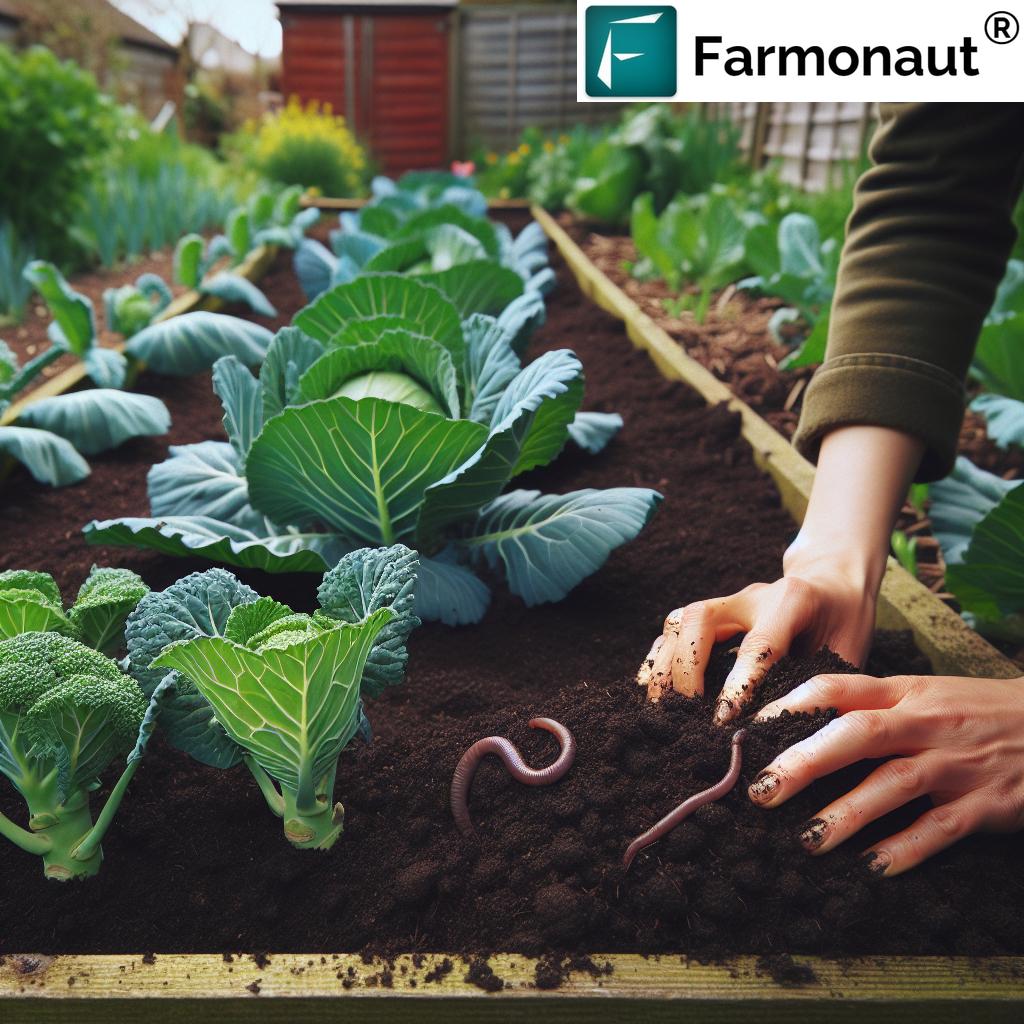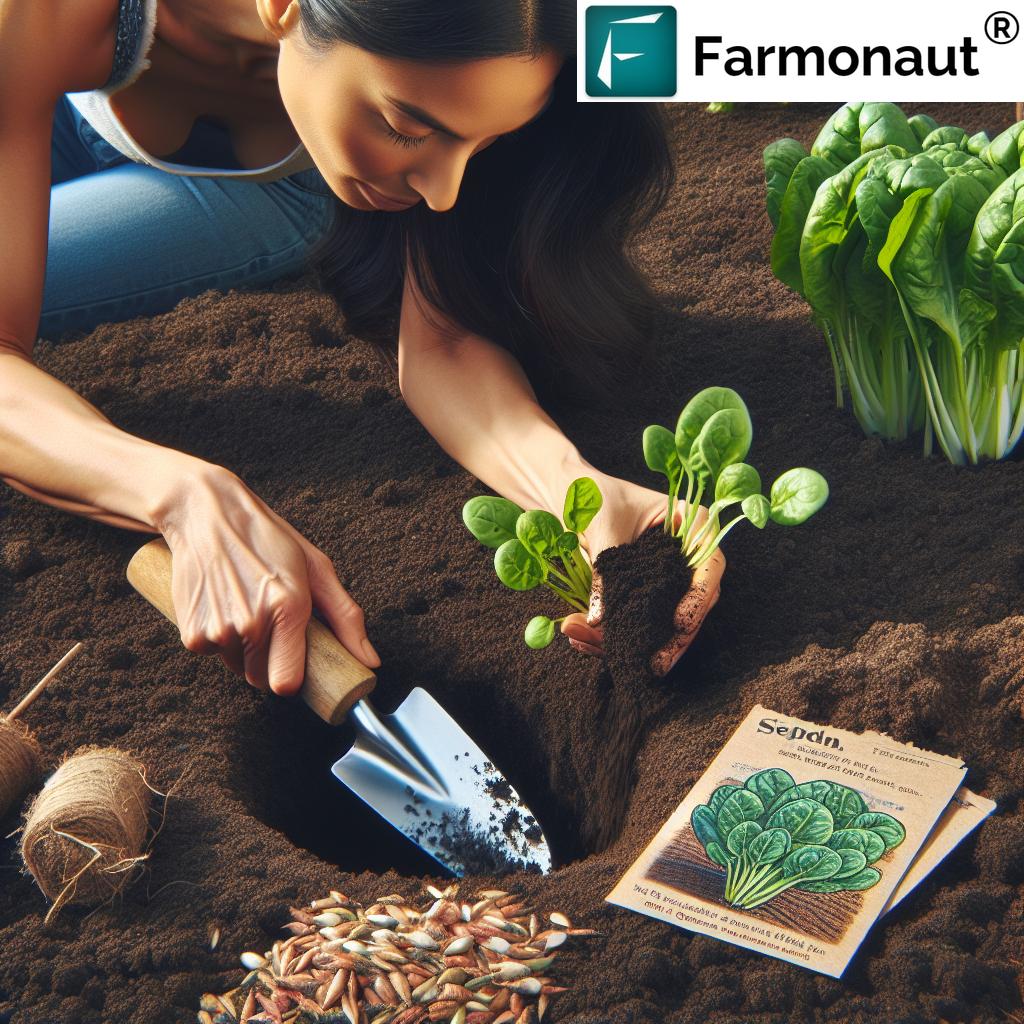Macon’s Ultimate Spring Gardening Guide: Master Soil Preparation and Early Planting for a Thriving Backyard Harvest
Spring is in the air, and for gardening enthusiasts in Macon, it’s time to roll up our sleeves and prepare for a bountiful season of growth. In this comprehensive guide, we’ll explore essential spring gardening tips and soil preparation techniques that will set the foundation for a thriving backyard garden. From mastering the art of soil aeration to selecting the perfect early spring vegetables, we’ve got you covered. Let’s dive in and discover how to create the ideal environment for your plants to flourish!

“Incorporating just 5% organic matter can increase soil water holding capacity by up to 20%, enhancing plant growth.”
The Foundation of Success: Soil Preparation
As we embark on our spring gardening journey, it’s crucial to understand that the secret to a thriving garden lies beneath our feet. Proper soil preparation is the cornerstone of a successful harvest, and it’s where we’ll begin our adventure.
Aeration: Giving Your Soil Room to Breathe
One of the first steps in preparing soil for planting is aeration. This process involves loosening compacted soil, allowing air, water, and nutrients to penetrate deeper into the ground. Here’s how we can achieve this:
- Use a garden fork or tiller to turn over the soil to a depth of 8-12 inches
- Break up large clumps of soil to create a finer texture
- Remove any rocks, roots, or debris that could impede root growth
By aerating our soil, we’re creating an environment where roots can easily grow and access the resources they need. This simple step can dramatically improve plant health and yield.
Incorporating Organic Matter: Nature’s Nutrient Boost
Next on our list of organic soil enrichment methods is the addition of organic matter. This crucial step improves soil structure, increases water retention, and provides a slow-release source of nutrients for our plants. Here’s what we recommend:
- Add 2-3 inches of compost to the top of your soil
- Mix in well-rotted manure for an extra nutrient boost
- Consider incorporating leaf mold or peat moss for improved soil structure
Remember, as Susan Fisher from the UGA Extension wisely said, “If you don’t have good soil, you’re going to struggle.” By enriching our soil with organic matter, we’re setting the stage for robust plant growth and a bountiful harvest.
The Power of Compost: A Gardener’s Best Friend
Composting for healthy plants is a practice that can’t be overstated. Not only does it provide essential nutrients, but it also introduces beneficial bacteria and fungi that contribute to a thriving soil ecosystem. Here’s how to make the most of compost in our spring garden:
- Layer compost in the top few inches of your planting area
- For late-season planting, incorporate compost deeper into the soil
- Use compost tea as a natural, nutrient-rich fertilizer throughout the growing season
By harnessing the power of compost, we’re not just feeding our plants; we’re nurturing the entire soil food web that supports them.
Selecting the Right Crops for Early Spring
With our soil primed and ready, it’s time to consider which crops will thrive in the early spring conditions of Macon. Choosing the right vegetables is crucial for a successful start to the growing season.
Cool-Season Favorites: Brassicas and Beyond
When it comes to the best vegetables to plant in early spring, brassicas are at the top of our list. These cool-season crops are perfect for Macon’s early spring weather. Here are some top choices:
- Cabbage
- Collards
- Broccoli
- Spinach
- Onions
- Radishes
These hardy vegetables can withstand cooler temperatures and even light frosts, making them ideal for early planting.
Understanding Growing Conditions
To ensure success with our early spring planting, it’s essential to understand the specific growing conditions each crop requires. Here are some key factors to consider:
- Soil temperature: Most cool-season crops prefer soil temperatures between 40°F and 75°F
- Frost tolerance: Some vegetables can withstand light frosts, while others need protection
- Sunlight requirements: Most spring vegetables need at least 6 hours of direct sunlight daily
- Water needs: Consistent moisture is crucial for young plants, but avoid waterlogged soil
By matching our crop selection to the prevailing conditions, we set ourselves up for gardening success.
“Early spring brassicas like cabbage and broccoli can be planted when soil temperatures reach 40°F (4.4°C), jumpstarting the growing season.”
Planting Techniques for a Thriving Garden
Now that we’ve prepared our soil and selected our crops, it’s time to get planting! Proper planting techniques are crucial for giving our vegetables the best start in life.
The Art of Hole Digging
One of the most valuable tips we can share for backyard garden preparation is to dig slightly larger holes than you think you need. This approach offers several benefits:
- Allows roots more room to expand and access nutrients
- Provides an opportunity to incorporate additional compost directly into the planting hole
- Improves drainage around the plant’s root zone
Remember to add a handful of compost to the bottom of each hole before placing your plant. This extra boost of nutrients will help your vegetables establish themselves quickly.
Spacing and Depth: Getting It Right
Proper spacing and planting depth are critical factors in ensuring healthy plant growth. Here’s what to keep in mind:
- Follow the spacing recommendations on seed packets or plant labels
- Plant seeds at a depth of about 2-3 times their diameter
- For transplants, plant at the same depth they were growing in their containers
- Leave enough space between rows for easy access and good air circulation
By giving our plants the right amount of space, we’re promoting healthy growth and reducing competition for resources.

The Secret Weapon: Worm Castings
For an extra boost to our spring garden, we can’t overlook the power of worm castings in gardening. These nutrient-rich byproducts of earthworm digestion offer a wealth of benefits:
- High in essential plant nutrients like nitrogen, phosphorus, and potassium
- Improve soil structure and water retention
- Contain beneficial microorganisms that enhance soil health
- Act as a slow-release fertilizer, providing nutrients over time
To incorporate worm castings into our planting routine, we can mix a handful into each planting hole or use them as a top dressing around established plants. For those interested in a sustainable approach, consider setting up a worm composting bin to produce your own castings at home.
Post-Planting Care: Mulching and Maintenance
Once our plants are in the ground, our work isn’t over. Proper post-planting care is essential for ensuring a thriving garden throughout the spring season.
The Magic of Mulch
Applying mulch to our newly planted garden beds is one of the most beneficial steps we can take. The mulching benefits for gardens are numerous:
- Regulates soil temperature, keeping roots cool as the weather warms
- Retains moisture, reducing the need for frequent watering
- Suppresses weed growth, minimizing competition for resources
- Adds organic matter to the soil as it breaks down over time
For optimal results, apply a 2-3 inch layer of organic mulch around your plants, being careful not to pile it against the stems or trunks.
Watering Wisdom
Proper watering is crucial for establishing healthy plants. Here are some tips to keep in mind:
- Water deeply and less frequently to encourage deep root growth
- Use a soaker hose or drip irrigation system for efficient watering
- Water early in the morning to reduce evaporation and fungal growth
- Monitor soil moisture regularly, adjusting watering as needed
Remember, consistent moisture is key, especially for young plants and seedlings.
Interpreting Seed Packets: A Gardener’s Roadmap
As we embark on our spring planting journey, it’s crucial to understand the wealth of information provided on seed packets. These small envelopes are treasure troves of knowledge that can significantly impact our gardening success.
Decoding the Details
Seed packets contain vital information about planting times, spacing, and care requirements. Here’s what to look for:
- Planting depth: How deep to sow the seeds for optimal germination
- Spacing: The recommended distance between plants for healthy growth
- Days to germination: How long to expect before seeing sprouts
- Days to maturity: The estimated time from planting to harvest
- Sun requirements: Whether the plant prefers full sun, partial shade, or full shade
- Watering needs: Guidelines for keeping your plants properly hydrated
By carefully following these instructions, we can create ideal growing conditions for each type of vegetable in our spring garden.
Succession Planting: Extending the Harvest
Many seed packets also provide information on succession planting, a technique that can help us extend our harvest throughout the season. Here’s how it works:
- Plant small batches of quick-maturing crops every 1-2 weeks
- As one crop is harvested, another is ready to take its place
- This method ensures a continuous supply of fresh vegetables
Crops like lettuce, radishes, and spinach are perfect for succession planting in our Macon spring gardens.
Spring Vegetable Planting Guide for Macon
To help you plan your spring garden, we’ve compiled a handy reference table for some popular vegetables suitable for early planting in Macon:
| Vegetable Name | Ideal Planting Time | Soil Temperature | Days to Harvest |
|---|---|---|---|
| Cabbage | Early March | 40°F (4.4°C) | 60-100 days |
| Collards | Mid-February to Early March | 45°F (7.2°C) | 60-75 days |
| Broccoli | Early March | 40°F (4.4°C) | 50-80 days |
| Spinach | Late February to Early March | 35°F (1.7°C) | 40-50 days |
| Onions | Mid-February to Early March | 50°F (10°C) | 90-120 days |
| Radishes | Early March | 40°F (4.4°C) | 20-30 days |
| Peas | Late February to Early March | 45°F (7.2°C) | 60-70 days |
Use this table as a starting point for planning your spring garden, but remember to also consider local weather patterns and microclimate variations in your specific area of Macon.
Enhancing Your Gardening Experience with Technology
While traditional gardening wisdom is invaluable, modern technology can significantly enhance our spring gardening efforts. Innovative tools and platforms can provide detailed insights into soil health, weather patterns, and crop management strategies.
One such platform is Farmonaut, which offers advanced satellite-based farm management solutions. While primarily designed for larger agricultural operations, many of its principles and technologies can be applied to backyard gardening as well.
Satellite-Based Crop Monitoring
Farmonaut’s satellite-based crop monitoring technology can provide valuable insights for gardeners, such as:
- Vegetation health indices (like NDVI) to assess plant vigor
- Soil moisture level estimates to optimize watering schedules
- Early detection of potential pest or disease issues
While the full suite of Farmonaut’s services might be more than a typical backyard gardener needs, understanding these technologies can help us make more informed decisions about our garden’s health and productivity.
Weather Data for Informed Decision Making
Access to accurate, localized weather data is crucial for successful spring gardening. Platforms like Farmonaut provide detailed weather forecasts and historical data that can help us:
- Plan planting dates based on temperature trends
- Anticipate and prepare for frost events
- Optimize irrigation based on rainfall predictions
By leveraging this type of data, we can make more informed decisions about when to plant, how to protect our crops, and how to manage water resources efficiently.
AI-Powered Gardening Advice
Artificial intelligence is making its way into the gardening world, offering personalized advice based on a variety of factors. While Farmonaut’s Jeevn AI system is designed for large-scale farming, similar principles can be applied to backyard gardening:
- Customized planting recommendations based on local climate data
- Pest and disease identification through image recognition
- Tailored fertilization and irrigation schedules
As these technologies become more accessible to home gardeners, they have the potential to significantly enhance our spring gardening success.
Sustainable Gardening Practices for a Greener Future
As we embrace spring gardening in Macon, it’s important to consider the environmental impact of our practices. Sustainable gardening not only benefits the planet but can also lead to healthier, more productive gardens.
Water Conservation Techniques
Efficient water use is crucial for sustainable gardening. Here are some techniques to conserve water in your spring garden:
- Install a rain barrel to collect and store rainwater for irrigation
- Use drip irrigation or soaker hoses for targeted watering
- Apply mulch to reduce evaporation and retain soil moisture
- Choose drought-tolerant plant varieties when possible
By implementing these water-saving strategies, we can maintain a thriving garden while minimizing our environmental impact.
Natural Pest Control Methods
Avoiding chemical pesticides is not only better for the environment but also promotes a healthier ecosystem in your garden. Consider these natural pest control methods:
- Encourage beneficial insects by planting companion flowers
- Use physical barriers like row covers to protect plants from pests
- Practice crop rotation to disrupt pest life cycles
- Make homemade organic sprays using ingredients like neem oil or garlic
These methods help maintain a balance in your garden ecosystem while keeping harmful pests at bay.
Soil Health and Carbon Sequestration
Healthy soil is the foundation of a sustainable garden. By focusing on soil health, we can also contribute to carbon sequestration, helping to mitigate climate change. Here’s how:
- Minimize soil disturbance by using no-till or low-till methods
- Incorporate cover crops to add organic matter and prevent soil erosion
- Use compost and organic fertilizers instead of synthetic ones
- Avoid leaving soil bare by mulching or planting ground covers
These practices not only improve soil fertility but also help lock carbon into the soil, reducing greenhouse gas emissions.
Frequently Asked Questions
To wrap up our comprehensive guide to spring gardening in Macon, let’s address some common questions:
Q: When is the best time to start my spring garden in Macon?
A: In Macon, you can typically start planting cool-season crops in late February to early March, depending on the specific vegetable and weather conditions. Always check local frost dates and weather forecasts before planting.
Q: How often should I water my spring garden?
A: Watering frequency depends on various factors, including soil type, weather conditions, and plant species. Generally, aim to keep the soil consistently moist but not waterlogged. Most gardens benefit from deep watering 1-2 times per week rather than frequent light watering.
Q: What are some easy vegetables to grow for beginners?
A: Some beginner-friendly vegetables for spring planting include radishes, lettuce, spinach, and peas. These crops are relatively low-maintenance and have shorter growing seasons, providing quick rewards for new gardeners.
Q: How can I protect my spring plants from late frosts?
A: To protect your plants from late frosts, you can use row covers, cloches, or even old bedsheets to cover them overnight. Remove the covers during the day to allow sunlight and air circulation. You can also use mulch around plants to insulate the soil.
Q: Is it necessary to fertilize my spring garden?
A: While a well-prepared soil rich in organic matter may not need additional fertilization, many plants benefit from a balanced, slow-release organic fertilizer applied at planting time. Always follow the recommendations on the fertilizer package and avoid over-fertilizing, which can harm plants and the environment.
Conclusion: Embracing the Spring Gardening Season in Macon
As we conclude our journey through Macon’s ultimate spring gardening guide, we hope you feel inspired and equipped to create a thriving backyard harvest. From mastering soil preparation techniques to selecting the perfect early spring vegetables, we’ve covered the essential steps to set your garden up for success.
Remember, gardening is both an art and a science. While we’ve provided a wealth of information and tips, don’t be afraid to experiment and learn from your experiences. Each garden is unique, and part of the joy of gardening is discovering what works best in your specific environment.
As you embark on your spring gardening adventure, keep these key points in mind:
- Prioritize soil health through proper preparation and organic enrichment
- Choose vegetables suited to Macon’s early spring climate
- Implement sustainable gardening practices for long-term success
- Stay informed about local weather patterns and frost dates
- Embrace technology to enhance your gardening experience
With patience, care, and a bit of hard work, your spring garden will reward you with a bountiful harvest of fresh, homegrown vegetables. Happy gardening, Macon!
For those interested in exploring more advanced agricultural technologies and insights, consider checking out the resources available at Farmonaut. While primarily focused on larger-scale farming, many of their principles and tools can be adapted for backyard gardening enthusiasts looking to take their hobby to the next level.
App and API Resources:
For developers interested in integrating agricultural data into their own applications, check out the Farmonaut API and the comprehensive API Developer Docs.
Earn With Farmonaut: Affiliate Program
Earn 20% recurring commission with Farmonaut’s affiliate program by sharing your promo code and helping farmers save 10%. Onboard 10 Elite farmers monthly to earn a minimum of $148,000 annually—start now and grow your income!







